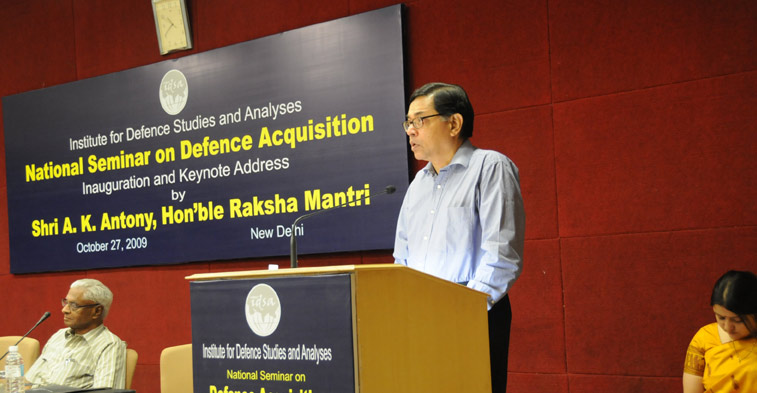
- This event has passed.
Special Address at National Seminar on Defence Acquisition
October 27, 2009

It is a privilege to address this National Seminar on Defence Acquisition considering how critical the modernisation programme is to the armed forces.
The present defence procurement and management structures in the Ministry of Defence (MoD) were set up in 2001 in terms of the recommendations of the Group of Ministers (GOM) on reforming the national security system, constituted in the wake of the Kargil conflict. The GOM recommended the setting up the Acquisition Wing with the task of expediting the acquisition of the capital equipment required for the modernisation programmes of the three services. For facilitating a seamless decision making procurement process, the Acquisition Wing was established as an inter-disciplinary body comprising of personnel drawn from the three Services and MoD.
One of the first tasks undertaken by the Acquisition Wing was to codify the procurement procedures, last attempted in 1992. The initial formulation in 2002 and four subsequent revisions were to de-mystify and introduce increasing levels of transparency based on experience gained in implementation. Defence procurement planning structures were formalised with detailed exercises for drawing up the 15 years Long Term Integrated Perspective Plan (LTIPP), the 5 years Services Capital Acquisition Plans (SCAP), and the Annual Acquisition Plans (AAPs) of the three Services. The consultative character of the new system, as opposed to a hierarchical system, is manifested in the effective and regular functioning of the Defence Acquisition Council (DAC) and the Defence Procurement Board (DPB). At the same time, the HQ IDS was organised in a manner that would ensure that all procurement proposals sent by the Services are vetted professionally while ensuring complete inter-Services coordination. Simultaneously, attention was focussed on monitoring ongoing contracts for the utilisation of the Capital Acquisition budget. These initiatives resulted in increasing the actual expenditure on capital acquisition schemes from Rs. 10,502 crores in 2000-01 to Rs. 27,903 crores in 2007-08 with the BE for 2009-10 standing at Rs. 40,368 crores. While there has been criticism about the surrender of funds with reference to BE/RE, it must be emphasised that “the acquisition of defence equipment is a complex and intricate process which needs to meet the twin objectives of modernisation of the Armed Forces within reasonable timeframes while conforming to the highest standards of transparency, probity, and public accountability” (RM’s Foreward to DPP 2008) in a functioning democracy that is India. Moreover, in the context of surrender of funds, it must be stated that there have been instances when the defence budget has been curtailed entirely on account of resource constraints.
There is, however, always room for improvement and criticism has to be taken in the right spirit. The Kelkar Committee’s recommendations [in its Report (Part-I) in 2005] that a “body like DGA (of France] seems suitable in the Indian set up”, was therefore, examined in MoD. The Concept Note for this Seminar states that a similar recommendation has been made by the Comptroller and Auditor General of India (C&AG) based on his observations of certain deficiencies in our capital acquisition structure/procedures. Before any stand is taken, a brief statement on the functioning of the DGA of France would be necessary.
The DGA was set up in 1961 for providing the French armed forces the necessary equipment, at the best cost, and in due time. DGA has several Directorates, each charged with specific responsibilities. These include monitoring research activities, conducting common technological developments, designing land lased, naval, aeronautical and tactical missile programmes, fund management, budget preparation, procurement, quality and logistics support (including maintenance), promoting export of French military equipment, providing technical expertise and skills required by programme managers for testing equipment and system, design, building and maintaining warships for French navy and for export, and maintaining aircraft and industrial facilities.
Replicating the DGA in India would, therefore, imply combining the functions presently discharged by the DRDO, the three Services HQs, DGQA, the Department of the Defence Production and the Defence PSUs under one umbrella organisation. In my view, several issues that would arise in the process would need to be thoroughly examined for a clear understanding of their implications. One major issue, is the feasibility of setting up a separate cadre for the Acquisition wing comprising of subject experts. Present experience shows that by the time an officer posted in the Acquisition Wing picks up requisite expertise, she/he is posted out. Postings in and out of the Acquisition wing are also dependent on the requirements of respective cadre controlling authorities, often to the detriment of ongoing programmes. While this appears to suggest that there is merit in having a separate Acquisition cadre, as in the DGA, it would be necessary to examine whether this is desirable.
There are other issues that would have to be thoroughly examines before any decision on replicating the DGA in India is taken. This will take time as it may be recalled that some institutions in the DGA, such as the Engineer General, has its origins in the Napolioinc wars, more than two hundred years ago. While I hope that it would not take India quite that long to restructure her defence acquisition management structures and systems, some patience is due.







